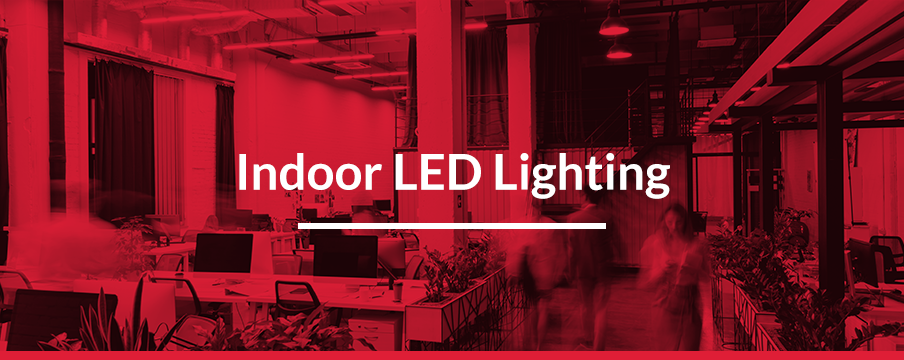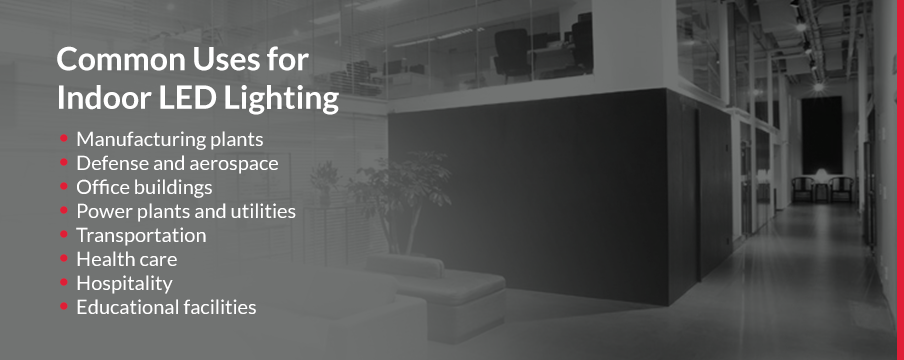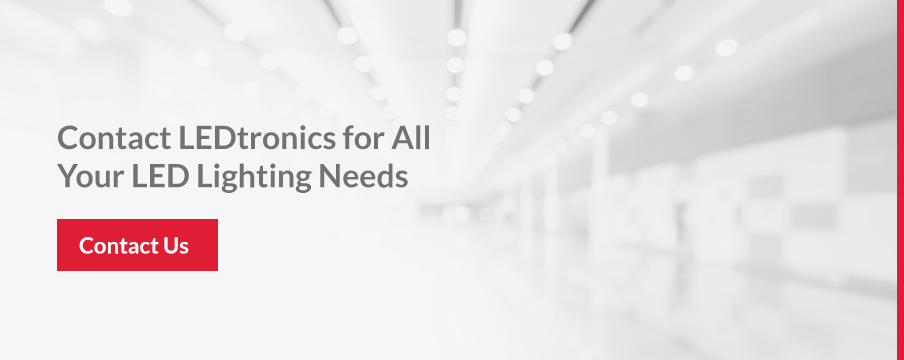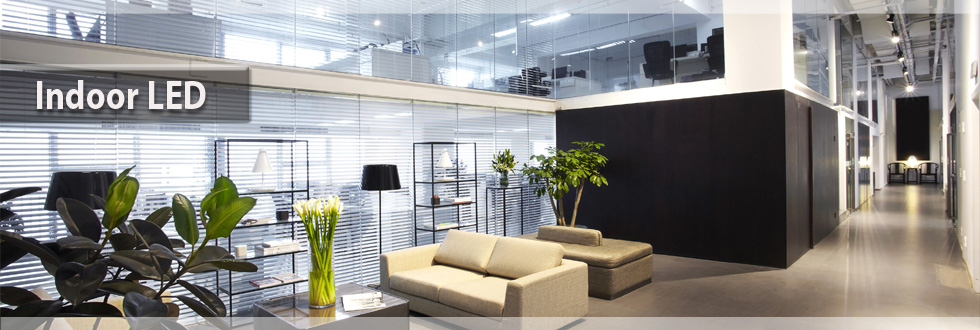Indoor LED Lighting

Like breathing, lighting is essential — we couldn't function without it. But lighting a large business can be expensive, and it can also drain your energy resources.
Traditional incandescent lighting, halogen lighting and fluorescent lighting can all be costly to operate and require huge amounts of power. According to the U.S. Energy Administration, commercial lighting consumes
about 141 billion kilowatt-hours a year
, which makes up about 10% of all commercial expenses. And in the manufacturing sector, lighting consumes an extra 55 billion kilowatt-hours a year.
Fortunately, light-emitting diodes, or LEDs, offer solutions to these issues and more. Below, we'll discuss some of the benefits of indoor LED lighting and how businesses can use it across an array of different industries.
Types of Indoor LED Lights
Indoor LEDs come in a variety of different types:
- Tube lights:
LED tube lights
are excellent for replacing existing fluorescent lighting with more natural and efficient illumination. They can also be used to create long rows of lighting.
- High and low bay lights: LED
high bay lights and low bay lights
are perfect for illuminating large areas like Warehouses. Many high and low bays are also available in different color temperatures, so you can select a warmer or cooler light for an illumination that best suits your business purposes.
- Ceiling light panels:
LED ceiling lights come in a variety of styles, including thin panels. These LED troffer lights are ideal for creating beautiful natural lighting for your office workers and other indoor employees.
- CFL replacement lamps: CFLs, or compact fluorescent lamps, are the spiral-shaped bulbs that many people use to replace traditional incandescent bulbs. These are a good start, but
LED replacements are much
more efficient.
- Canopy lights: Square and linear
canopy lights make excellent overhead lighting. They are sturdy and provide robust overhead lighting for places like warehouses, factory floors, or anywhere a lot of light is needed.
- Linear lighting:
Linear lighting is useful in a multitude of settings, from aisle lighting in factories and department stores to workshops, convention centers, warehouses and more. Some are designed for use in dusty or wet environments for extra protection.
- LED bulbs:
LED bulbs work great to replace older-style incandescent lighting. Some decorative models even have a filamented design to reproduce the look of old-timey bulbs or chandelier lights.
- Retrofit lighting:
Retrofit lighting helps convert old lighting systems to more energy-efficient LED systems. Retrofit lighting screws into existing fixtures to reduce installation time and cost.
- Downlights:
LED downlights are typically recessed light that direct their light downward for a more focused, concentrated area of illumination. They can be used to spotlight different features at a convention hall, to provide soft lighting in an office reception area or in a variety of other applications.
- Neon rope and strip lighting:
Neon rope and strip lighting can be used to create illuminated lighting paths — like those on an airplane, but for any business. You can use them to provide a path to exits, for building perimeter lighting or create fun designs at a convention center or show. In addition, LED neon rope lights provide better night visibility for strip malls, restaurants and other establishments.
Common Uses for Indoor LED Lighting

Indoor LED lights find uses in a wide array of applications and different industries:
- Manufacturing plants: In industrial manufacturing plants, safety is crucial on the floor. Employees need to be able to see what they're doing so they don't injure themselves or others — and so they can attend to precise details, keeping product quality high. LED lights meet the need for bright, natural lighting while helping manufacturing plants keep costs down. They can also function as indicator lights for different systems, circuit boards or
control rooms
in the plant.
- Defense and aerospace:
Defense and aerospace industries deal in many complex electronic systems — communications, navigation and much more. LED lights can be used in aircraft instrument panels, equipment marker lights, ship bridge controls, submarine lights and landing pads, as well as in settings like offices, corridors and elevators.
- Office buildings: LED lights are useful in
commercial office buildings as well. There's a reason that the long, hard day at the office is a standard trope — office work is draining, even if it doesn't involve heavy lifting or backbreaking labor. And harsh lighting increases the strain on employees. But natural lighting of LED ceiling panels helps office employees feel more comfortable at work. LED lights can also work as
indicator lights in elevators or on communications systems.
- Power plants and utilities:
Power plants and utility facilities need a variety of illuminated control systems, as well as general indoor lighting for the facility. These facilities can be expensive to power, but LED lighting helps make sure the lighting systems use minimal resources.
- Transportation:
Transportation industries need led lamps to light tunnels, subway stations and landing areas, to light automotive manufacturing warehouses, and to provide lighting within the passenger compartments.
- Health care: Along with food sales and education, health care is one of three industries that
lights at least 90% of its floor space. Adequate lighting is crucial in
health care settings so physicians and nurses can see the minute details of their work. Patients also need to be as comfortable as possible, and natural LED lighting helps health care facilities accomplish that goal.
- Hospitality:
Many hotels use lighting to create a welcoming ambiance for their guests and to make themselves stand out to busy, tired travelers. LED lighting makes hotel lighting practical and affordable.
- Educational facilities:
Educational institutions like schools and universities need to provide an inviting educational atmosphere for students, and natural LED overhead lighting helps do just that. Fluorescent lighting can
contain mercury and other chemicals that are harmful to students' developing brains, but LED lights help keep students safe and healthy.
Benefits of Indoor LED Lighting
Indoor LED lighting offers several general benefits to any industry:
- Safety: In any industry, employee safety is paramount. Accidents on the job harm employees' health and well-being, and they also diminish productivity and employee morale. Providing quality, natural LED lighting is one way to help employees remain safe on the job.
- Visibility: To create high-performing products, employees need to be able to see the minutest details of their work. Bright, natural LED lighting helps make sure no flaw goes unnoticed.
- Versatility: As we've discussed above, LED lights come in a wide range of different options. So businesses across varied industries can choose the type of fixtures that work best for their purposes.
LED Benefits vs. Benefits of Other Kinds of Bulbs
LEDs also offer several specific benefits:
- Energy-efficiency: LED lights are more energy-efficient than other types of lighting. To help make your workplace more environmentally friendly, invest in LED lighting to use less power — from 25% to an enormous
80% less than incandescent bulbs— for the same amount of bright illumination.
- Reduced operating costs: This energy efficiency also translates to substantial cost savings for just about any business. Using less power means you save on your power bill, which is great news overall and also lets your business quickly recoup the cost of a new LED light installation.
- Employee satisfaction and productivity: Many people find it challenging to work under harsh fluorescent lighting. In an artificially lit environment, employee moods may suffer, and their productivity may also suffer. But LED lights offer a more natural illumination that employees can feel more comfortable in. LED lighting can help make employees happier, more focused and more productive.
- Low maintenance: Traditional bulbs tend to burn out regularly and need to be changed, causing inconvenience and lost time. But LED lights have a long lifespan, so you can spend your time on other work and not worry about hauling out a ladder to change high overhead lights.
Indoor Lighting from LEDtronics
For LED light fixtures, LEDtronics stands apart from other companies. Here are a few of the unique benefits we offer:
- Energy and money-saving sensors: Our new generation of indoor LED lights uses sensors for autodimming so you won't use more light than you need. These sensors lead to savings in both energy and money.
- A variety of fixtures: LEDtronics offers a huge array of different LED light fixtures for all your business needs. From LED thin panels and tube lights to troffers and more, our lights offer flexibility and customization so you get just the right amount and style of illumination for your space.
- Expertise: When you buy indoor LED lights from us, you also get the wealth of expertise that we are happy to share. We have the most LED knowledge of anyone in the business and can consult with you to make sure you get the solutions you need.
Contact LEDtronics for All Your LED Lighting Needs

When you need LED lighting for your business, come to LEDtronics. We offer a range of indoor LED light fixtures and industrial indoor LED lamps, so businesses can choose what works best for them. Other companies sell huge varieties of lighting — we specialize in LED, so our extensive knowledge can also help us give you the answers you need.
Contact us today to learn more.



